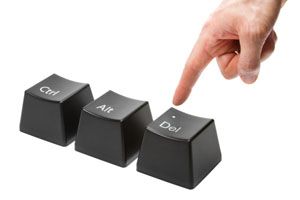Boot Up Problems


As soon as you switch on the power supply to your computer, the computer’s BIOS starts and along with it the CMOS program also begins. The CMOS program starts checking all hardware devices in the computer, like the processor and memory. After this it moves on to checking various other drives like CD ROM, DVD ROM, hard drive, USB drive and the floppy drive as well. Once all this is checked, it moves on to checking various files, cards and any other devices installed on the computer. The BIOS then looks out for any floppy present in the floppy drive for it to boot from. In the absence of one, it boots from the hard drive and then loads the windows registry. Any hindrance in the above process can be a cause of problems when booting up. There could be a variety of other problems which could affect your computer.
Booting Up Errors in Windows XP and Vista
Computer Reboots When Shutdown Command is Given
If you give the shut down command and your computer restarts instead, it means there is something causing a system failure during the shutdown process. To stop this, you will have to click on the ‘Start’ button and click on ‘Run’. In ‘Run”, type ‘sysdm.cpl’ and hit ‘Enter’. In the window that appears, you will have to click on the Advanced Tab → Settings → Start up and Recovery. Go to the ‘Automatically Restart’ option and uncheck the box next to it.
You will notice that your windows has stopped rebooting but the system failure problem still persists. However, the error message windows will display when your computer starts, will give you the cause of the problem. At times, this problem could also be due to a hardware error. It is therefore advisable to call a qualified computer repair personnel to solve this problem.
Computer Freezes at Windows Boot Up Screen
If your computer screen freezes before windows is loaded from the hard drive, there is a hardware problem. To figure this out, try booting your computer from a USB flash drive or a CD/DVD. If your computer boots from any other drive apart from the hard drive, a fault in that particular drive could interfere with the booting even after you have emptied the drive. You will have to figure out which drive is causing the problem by changing the boot order from your BIOS settings. When your computer starts, you might get a message saying ‘Press F2 for Setup’ and look for ‘Boot Order’ or ‘Boot Options’. In the boot order, keep your first option as “Hard Drive’, and exit. If this stops your problem, you can try putting different devices in the first option and figure out which drive is faulty.
If the problem still continues, there is a serious hardware problem. Unplug all your motherboard connections and carefully connect them back properly once again, and see if it works. Your last option should be to call for an authorized computer repair agent who would help you fix this boot up problem.
Windows Needs a Password to Boot
Windows is programmed to ask for a password before starting, only to protect your computer from somebody else using it, without your consent. But if you have trustworthy people around, and don’t mind them using your desktop computer, you can easily remove this option. To turn off the password characteristic, you should first click on the ‘Start’ button and then on ‘Run’. In ‘Run’ type the command – ‘controluserpasswords2’, and hit ‘Enter’. In the window which appears, you will find an option ‘users must enter a username and password to use this computer. Uncheck the box next to this and click ‘OK’. Once you do this, a dialog box will appear on screen, wherein you need to type your username and password for the last time. Post this, your computer will boot automatically without asking you for any password.
Troubleshooting certain computer startup problems may require help from qualified technicians. This is when problems are due to certain technical issues which are beyond comprehension of common people lacking specific knowledge. Regularly updating and maintain your computer is enough to keep most problems at bay.

